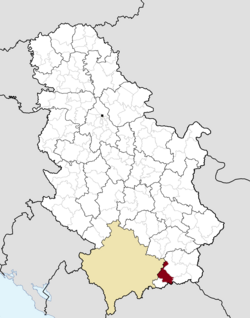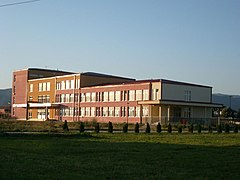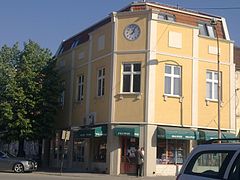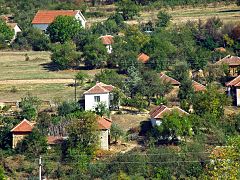Town and municipality in Southern and Eastern Serbia, Serbia
| Bujanovac
Бујановац (Serbian) Bujanoc (Albanian) | |
|---|---|
| Town and municipality | |
 Building in the center Building in the center Bujanovac Mosque Bujanovac Mosque Sezai Suroi Gymnasium Sezai Suroi Gymnasium Railway station Railway station | |
 Coat of arms Coat of arms | |
 Location of the municipality of Bujanovac within Serbia Location of the municipality of Bujanovac within Serbia | |
| Coordinates: 42°28′N 21°46′E / 42.467°N 21.767°E / 42.467; 21.767 | |
| Country | |
| Region | Southern and Eastern Serbia |
| District | Pčinja |
| Settlements | 59 |
| Government | |
| • Mayor | Nagip Arifi |
| Area | |
| • Town | 8.95 km (3.46 sq mi) |
| • Municipality | 461 km (178 sq mi) |
| Elevation | 384 m (1,260 ft) |
| Population | |
| • Town | 11,468 |
| • Town density | 1,300/km (3,300/sq mi) |
| • Municipality | 41,068 |
| • Municipality density | 89/km (230/sq mi) |
| Time zone | UTC+1 (CET) |
| • Summer (DST) | UTC+2 (CEST) |
| Postal code | 17520 |
| Area code | +381(0)17 |
| Car plates | BU |
| Website | www |

Bujanovac (Serbian Cyrillic: Бујановац, pronounced [bǔjanɔvats]; Albanian: Bujanoc) is a town and municipality located in the Pčinja District of southern Serbia. As of the 2022 census, the municipality has a population of 41,068.
Situated in the South Morava basin, it is located in the geographical area known as Preševo Valley. It is also known for its source of mineral water and spa town Bujanovačka banja. Ethnically, Serbs are the largest ethnic group in the town, while the largest ethnic group in the municipality are Albanians.
History
Ancient history
Kale-Krševica, located south of Ristovac, is an archaeological site of a 5th-century BC Ancient city of Macedon, thought to be Damastion. The Thracian Triballi and Paeonian Agrianes dwelled in the region, with the Scordisci settling here after the Gallic invasion of the Balkans in 279 BC. The region was conquered by the Romans after 75 BC. It became part of the Roman propraetorial province Moesia in 29 BC (imperial from 27 BC). In 87 AD the region was re-organized into the Moesia Superior, which was a province of the Roman Empire.
Medieval Serbian era
Medieval Serbian state like the Kingdom of Serbia or the Serbian Empire included part of this region in the 12th century and most of it until the 14th century. Since the 15th century, the region was under Ottoman administration.
Ottoman era
It became part of Rumelia, as a historical term describing the area now referred to as the Balkans or the Balkan Peninsula when it was administered by the Ottoman Empire.
After the Berlin agreement, signed in 1878, there were some administrative changes in the Ottoman Empire. Bujanovac – then Buyanofça – and its surroundings became part of the "Preševo area" of the Priština District and in 1905–1912 Bujanovac belonged to the 2nd category of borough covering 28 villages. After the Balkan Wars, the area belonged to Kumanovo District of the Kingdom of Serbia.
Yugoslavia (1918–92)
After the establishment of the Kingdom of Serbs, Croats and Slovenians, in 1918, Bujanovac became part of Vranje Oblast, which was formed in 1921 after the Vidovdan Constitution. With administrative changes in 1929, it became part of Vardar Banovina, with the town of Skopje as capital. With the forming of Democratic Federal Yugoslavia, it was part of Socialist Republic of Serbia from 1943 to 1992. After World War II, in 1947, Bujanovac was established as one of 117 municipalities of Central Serbia, under its own name.
From 1945 until 1992 Bujanovac was part of Socialist Republic of Serbia, within SFR Yugoslavia.
Breakup of Yugoslavia (1991–99)

In 1992, the Albanians in the area organized a referendum in which they voted that Bujanovac, Preševo and Medveđa should join the self-declared assembly of the Republic of Kosova. However, no major events happened until the end of the 1990s.
Following the breakup of Yugoslavia, and nearby Kosovo War which lasted until 1999, between 1999 and 2001, an ethnic Albanian paramilitary separatist organization, the UÇPMB, raised an armed insurgency in the Preševo Valley, in the region mostly inhabited by Albanians, with a goal to occupy these three municipalities from Serbia and join them to the self-proclaimed Republic of Kosova.
Unlike in the case of Kosovo, western countries condemned the attacks and described it as the "extremism" and use of "illegal terrorist actions" by the group. Following the overthrow of Slobodan Milošević, the new Yugoslav government suppressed the violence by 2001 and defeated the separatists. NATO troops also helped the Yugoslav government by ensuring that the rebels do not import the conflicts back into Kosovo. Thereafter, the situation has stabilized even though large number of forces exist in this small municipality.
In 2009, Serbia opened a military base Cepotina five kilometers south of Bujanovac, to further stabilize the area.
Modern
Today, Bujanovac is located in the Pčinja District of southern Serbia.
On 7 March 2017, the President of Albania Bujar Nishani made a historical visit to the municipalities of Bujanovac and Preševo, in which Albanians form the ethnic majority.
Settlements
Aside from the town of Bujanovac, the municipality includes the following settlements:
- Baraljevac
- Biljača
- Bogdanovac
- Božinjevac
- Borovac
- Bratoselce
- Breznica
- Brnjare
- Buštranje
- Čar
- Dobrosin
- Donje Novo Selo
- Drežnica
- Đorđevac
- Gramada
- Gornje Novo Selo
- Jablanica
- Jastrebac
- Karadnik
- Klenike
- Klinovac
- Končulj
- Košarno
- Krševica
- Kuštica
- Letovica
- Levosoje
- Lopardince
- Lučane
- Lukarce
- Ljiljance
- Mali Trnovac
- Muhovac
- Negovac
- Nesalce
- Oslare
- Pretina
- Pribovce
- Rakovac
- Ravno Bučje
- Rusce
- Samoljica
- Sebrat
- Sejace
- Spančevac
- Srpska Kuća
- Sveta Petka
- Starac
- Suharno
- Trejak
- Turija
- Uzovo
- Veliki Trnovac
- Vogance
- Vrban
- Zarbince
- Žbevac
- Žuželjica
Demographics
| Year | Pop. | ±% p.a. |
|---|---|---|
| 1948 | 34,472 | — |
| 1953 | 36,810 | +1.32% |
| 1961 | 39,064 | +0.75% |
| 1971 | 43,522 | +1.09% |
| 1981 | 46,689 | +0.70% |
| 1991 | 49,238 | +0.53% |
| 2002 | 43,302 | −1.16% |
| 2011 | 18,067 | −9.26% |
| 2022 | 41,068 | +7.75% |
| Source: | ||
According to the 2002 census, the municipality of Bujanovac had a population of 43,302 people. Most of the municipality population live in rural areas, with only 27.74% living in the urban parts. The municipality of Bujanovac has 59 inhabited places. As of 2022 census, the municipality has 41,068 inhabitants.
Ethnic groups
The majority of the municipality population according to the 2022 census are Albanians, encompassing 62% of the total population. During the 2011 census, undercounting of the census units, owing to the boycott by most of the members of the Albanian ethnic community in the municipality of Bujanovac, was reported. The ethnic composition of the municipality is as follows:
| Ethnic group | Population 1948 |
Population 1953 |
Population 1961 |
Population 1971 |
Population 1981 |
Population 1991 |
Population 2002 |
Population 2011 |
Census2022 | |
|---|---|---|---|---|---|---|---|---|---|---|
| Population | % | |||||||||
| Albanians | 27,174 | 28,653 | 16,618 | 21,209 | 25,848 | 29,588 | 23,681 | 244 | 25,465 | 62.01 |
| Serbs | 25,143 | 27,681 | 20,033 | 18,840 | 15,914 | 14,660 | 14,782 | 12,989 | 10,467 | 25.49 |
| Romani | 2,838 | - | 11 | 2,749 | 4,130 | 4,408 | 3,867 | 4,576 | 3,532 | 8.60 |
| Macedonians | 29 | 54 | 40 | 55 | 105 | - | 36 | 47 | 16 | 0.32 |
| Bulgarians | 9 | 23 | - | - | - | - | 33 | 23 | 11 | |
| Gorani | - | - | - | - | - | - | 10 | 60 | 87 | |
| Montenegrins | 23 | 16 | 8 | 23 | 24 | 44 | 7 | 19 | - | |
| Muslims | 314 | - | 134 | 81 | 121 | 133 | 6 | 15 | 15 | |
| Yugoslavs | - | 91 | 1,081 | 15 | 96 | 75 | 2 | 3 | 2 | |
| Others | 408 | 6,286 | 1,147 | 550 | 451 | 330 | 878 | 91 | 1,473 | 3.59 |
| Total | 55,938 | 62,804 | 39,064 | 43,522 | 46,689 | 49,238 | 43,302 | 18,067 | 41,068 | 100 |
Religion
Based on the census results from 2022, the Bujanovac Municipality has 68.8% of Muslims majority and substantial 24.8% Christian Orthodox minority.
| Religious group | Census 2022 | |
|---|---|---|
| Population | % | |
| Islam | 28,254 | 68.80 |
| Orthodoxy | 10,203 | 24.84 |
| Other Christian | 423 | 1.03 |
| Others | 4 | 0.01 |
| Undeclared | 340 | 0.83 |
| Unknown | 1,844 | 4.49 |
| Total | 41,068 | |
Culture and society
Sports
Bujanovac has a number of football teams, the most notable being BSK Bujanovac, Kf Tërnoci and KF Besa.
Economy
The following table gives a preview of total number of registered people employed in legal entities per their core activity (as of 2022):
| Activity | Total |
|---|---|
| Agriculture, forestry and fishing | 32 |
| Mining and quarrying | 16 |
| Manufacturing | 1,291 |
| Electricity, gas, steam and air conditioning supply | 8 |
| Water supply; sewerage, waste management and remediation activities | 180 |
| Construction | 265 |
| Wholesale and retail trade, repair of motor vehicles and motorcycles | 685 |
| Transportation and storage | 328 |
| Accommodation and food services | 249 |
| Information and communication | 27 |
| Financial and insurance activities | 35 |
| Real estate activities | 2 |
| Professional, scientific and technical activities | 129 |
| Administrative and support service activities | 31 |
| Public administration and defense; compulsory social security | 609 |
| Education | 780 |
| Human health and social work activities | 369 |
| Arts, entertainment and recreation | 135 |
| Other service activities | 131 |
| Individual agricultural workers | 100 |
| Total | 5,401 |
Gallery
-
 Bujanovac Grammar's School
Bujanovac Grammar's School
-
 Town Center Building
Town Center Building
-
Bujanovac Bus Station
-
 Ljiljance village panorama
Ljiljance village panorama
International cooperation
Notable people
- Nexhat Daci, Kosovo Albanian politician
- Gjelbrim Taipi, Albanian footballer
- Berat Djimsiti, Albanian footballer
- Shaip Kamberi, Albanian Politician
- Lumir Abdixhiku, Kosovo Albanian politician
- Arbnor Fejzullahu, Albanian footballer
- Ajet Sopi Bllata, Albanian rebel
- Nagip Arifi , Albanian Politician
See also
References
- "Municipalities of Serbia, 2006". Statistical Office of Serbia. Retrieved 28 November 2010.
- "Насеља општине Бујановац" (PDF). stat.gov.rs (in Serbian). Statistical Office of Serbia. Archived from the original (PDF) on 14 November 2015. Retrieved 22 October 2019.
- ^ "Prvi rezultati Popisa stanovništva, domaćinstava i stanova 2022". stat.gov.rs (in Serbian). 21 December 2022. Retrieved 16 February 2023.
d
- "2022 Census of Population, Households and Dwellings" (PDF). Retrieved 7 December 2023.
- "SCIndeks - Članak". Archived from the original on 26 August 2011. Retrieved 15 November 2010.
- European Centre for Minority Issues Staf (1 January 2003). European Yearbook of Minority Issues: 2001/2. Martinus Nijhoff Publishers. p. 652. ISBN 90-411-1956-6.
- Lobjakas, Ahto. "NATO: Yugoslav Officials Discuss Presevo Valley". rferl.org. Radio Free Europe / Liberty. Retrieved 22 April 2017.
- "Otvorena baza na jugu Srbije". b92.net (in Serbian). Beta. 23 November 2009. Retrieved 6 March 2017.
- "Musliu: Albanski predsednik Bujar Nišani posetiće 7. marta Bujanovac i Preševo". blic.rs (in Serbian). Beta. 3 March 2017. Retrieved 11 March 2017.
- "2011 Census of Population, Households and Dwellings in the Republic of Serbia" (PDF). stat.gov.rs. Statistical Office of the Republic of Serbia. Retrieved 11 January 2017.
- ^ "НАЦИОНАЛНА ПРИПАДНОСТ Подаци по општинама и градовима 2022. у Републици Србији" (PDF). stat.gov.rs. Republički zavod za statistiku.
- "STALNO STANOVNISTVO PO NARODNOSTI" (PDF). stat.gov.rs. Republički zavod za statistiku. Retrieved 4 March 2015.
- "UKUPNO STANOVNIŠTVO PO NARODNOSTI (1953)" (PDF). stat.gov.rs. Republički zavod za statistiku. Retrieved 3 March 2015.
- "Knjiga III: Nacionalni sastav stanovništva FNR Jugoslavije (1961)" (PDF). stat.gov.rs (in Serbian). Republički zavod za statistiku. Retrieved 3 March 2015.
- "Knjiga III: Nacionalni sastav stanovništva FNR Jugoslavije (1971)" (PDF). stat.gov.rs (in Serbian). Republički zavod za statistiku. Retrieved 3 March 2015.
- "Nacionalni sastav stanovništva SFR Jugoslavije (1981)" (PDF). stat.gov.rs. Republički zavod za statistiku. Retrieved 3 March 2015.
- "STANOVNIŠTVO PREMA NACIONALNOJ PRIPADNOSTI (1991)" (PDF). stat.gov.rs. Republički zavod za statistiku. Retrieved 3 March 2015.
- "Popis stanovnistva, domacinstava i stanova u 2002" (PDF). stat.gov.rs (in Serbian). Retrieved 3 March 2015.
- "Попис становништва, домаћинстава и станова 2011. у Републици Србији" (PDF). stat.gov.rs. Republički zavod za statistiku. Archived from the original (PDF) on 11 August 2014. Retrieved 3 March 2015.
- "Претрага дисеминационе базе". data.stat.gov.rs. Retrieved 21 June 2023.
- "MUNICIPALITIES AND REGIONS OF THE REPUBLIC OF SERBIA, 2023" (PDF). stat.gov.rs. Statistical Office of the Republic of Serbia. Retrieved 20 September 2024.
Notes
| a. | At the time, today's municipality of Preševo was a part of Bujanovac. |
| b. | In the municipality of Bujanovac there was undercoverage of the census units owing to the boycott by most of the members of the Albanian ethnic community. |
